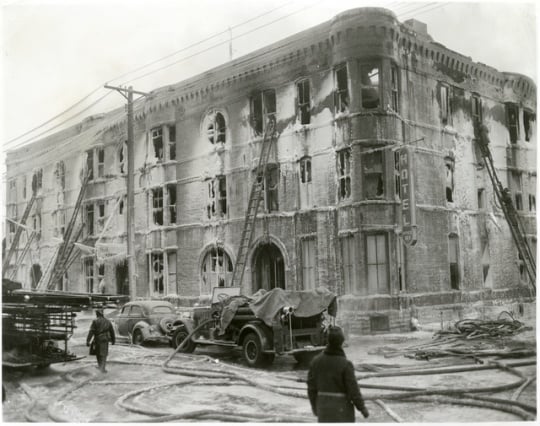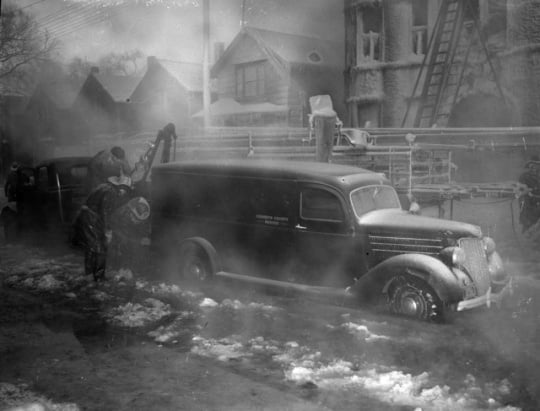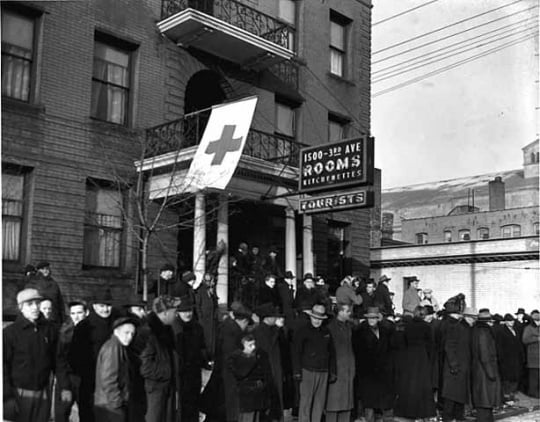Topics
Category
Era
Marlborough Apartment Hotel Fire, January 3, 1940
On January 3, 1940, the Marlborough Apartment Hotel in Minneapolis burst into flames after an explosion in its basement. The deadliest fire the city had ever seen would claim nineteen lives and destroy a three-story building housing more than one hundred twenty people.
Hotel janitor Otto Knaack was in the basement hallway just outside the boiler room at about 5:45 AM, when the explosion occurred. "All the windows in the boiler room were blown out," he reported. By the time he got his family assembled on the first floor, it "was burning so fiercely we couldn't get out. We had to jump to the ground six feet below. The whole place seemed to go up in flames suddenly."
Fire trucks raced to the scene, but they were hampered by near-zero temperatures, and the building was already a mass of flames by the time the first rigs reached the hotel. Observers reported hearing the trapped residents screaming for help and watching as they frantically smashed windows with fists, chairs, and shoes in efforts to escape. Firemen struggled with frantic victims as they tried carrying them to safety. One fireman was bringing a hysterical woman down the fire ladder when she struggled to get free. Both she and her rescuer fell two floors to the sidewalk and were seriously injured.
As the flames poured out of his third-floor apartment, one man could not wait for the ladders to reach him and his wife. He pushed her out the window, and she fell to her death. He leaped out the window after her, and survived.
One passerby, a twenty-nine-year-old cab driver named Henry Kadlac, joined in the rescue effort. Described as a hero by several observers, Kadlac caught many of the children who jumped out of the burning building or were tossed out by their parents.
Later, after the fire had been extinguished, Minneapolis Tribune reporter William Smollett described the smoldering ruins: "There was evidence everywhere that human beings once had lived in these blackened rooms. But you couldn't help but wonder how it was possible that anyone escaped."
The survivors, many of whom suffered severe burns and fractures, were rushed to Minneapolis General Hospital, where several of them were treated with sulfanilamide. The hospital's medical team had pioneered the use of this antibacterial ointment, which was considered a "wonder drug" of its time.
Fire investigators were not able to determine with certainty the cause of the blaze, but they speculated it might have been sparked by smoldering cigarette butts wrapped in garbage thrown down a trash chute.
The hotel, a forty-five-year-old brick and frame building, had been inspected four years earlier, when no violations of the city's fire code had been noted, according to the Minneapolis Star Journal. Later investigations confirmed there were no building deficiencies that could have caused the blaze. The building's owner, Henry Janise, who lived at the hotel, was in no way responsible for the disaster. Still, city building inspector John Nelson used the fire to call for stepped-up action against building-code violations.
The Star Journal's editor noted, "In this case, there is apparently no basis for exposé or crusade, no reason to believe that what happened was due to anybody's negligence or misfeasance. Yet whatever redoubling of safeguards comes as a result will be all to the good."
Bibliography
"Cab Driver Turned Hero Catches Tots Escaping from Flames." Minneapolis Star Journal, January 4, 1940.
"Probe into Fatal Hotel Fire To Be Launched Today." Minneapolis Morning Tribune, January 4, 1940.
Smollett, William. "Visit to Charred Hotel Ruins Makes Survival from Fire Seem Impossible." Minneapolis Morning Tribune, January 4, 1940.
"Worst Fire in City's History." Minneapolis Star Journal, January 3, 1940.
Related Resources
Primary
Annual Report of the Minneapolis Fire Department, Minneapolis, Minnesota. Minneapolis: Minneapolis Fire Department, 1940.
Secondary
"19 Die in Most Disastrous Fire." LIFE, January 14, 1940, 22–23
Disasters From July 1, 1939 to June 30, 1940: Official Report of Relief Operations. Washington D.C.: The American National Red Cross, [1940].
Heath, Richard. Mill City Firefighters: The First Hundred Years, 1879–1979. Minneapolis: The Extra Alarm Association of the Twin Cities, 1981.
Huyck, Adrian. The Adrian Huyck Notebook: Minneapolis Fire Department, 1857–1965. [Minneapolis]: The Extra Alarm Association, [1992].
Web
"Firefighters clear debris and search for bodies following Marlborough Hotel fire in Minneapolis." Newsreel video, 36 sec. January 3, 1940.
https://www.criticalpast.com/video/65675044324
Related Video
1940 Marlborough Hotel Fire
Holding Location
Related Images

Marlborough Apartment Hotel fire, Minneapolis
Holding Location
More Information

Minneapolis firefighters try to move a Hennepin County Morgue truck after being iced in during a Jan. 3 fire at the Marlborough Apartment Hotel
Holding Location
More Information

A crowd watches a fire at the Marlborough Apartment Hotel, Minneapolis
Holding Location
More Information
Turning Point
Near-zero temperatures impede rescue efforts by the city's fire department and leave the hotel's charred remains an icy ruin. Several residents leap to their deaths from third-floor windows, while others are trapped in their rooms before getting a chance to flee.
Chronology
January 3, 1940
January 4, 1940
Bibliography
"Cab Driver Turned Hero Catches Tots Escaping from Flames." Minneapolis Star Journal, January 4, 1940.
"Probe into Fatal Hotel Fire To Be Launched Today." Minneapolis Morning Tribune, January 4, 1940.
Smollett, William. "Visit to Charred Hotel Ruins Makes Survival from Fire Seem Impossible." Minneapolis Morning Tribune, January 4, 1940.
"Worst Fire in City's History." Minneapolis Star Journal, January 3, 1940.
Related Resources
Primary
Annual Report of the Minneapolis Fire Department, Minneapolis, Minnesota. Minneapolis: Minneapolis Fire Department, 1940.
Secondary
"19 Die in Most Disastrous Fire." LIFE, January 14, 1940, 22–23
Disasters From July 1, 1939 to June 30, 1940: Official Report of Relief Operations. Washington D.C.: The American National Red Cross, [1940].
Heath, Richard. Mill City Firefighters: The First Hundred Years, 1879–1979. Minneapolis: The Extra Alarm Association of the Twin Cities, 1981.
Huyck, Adrian. The Adrian Huyck Notebook: Minneapolis Fire Department, 1857–1965. [Minneapolis]: The Extra Alarm Association, [1992].
Web
"Firefighters clear debris and search for bodies following Marlborough Hotel fire in Minneapolis." Newsreel video, 36 sec. January 3, 1940.
https://www.criticalpast.com/video/65675044324





